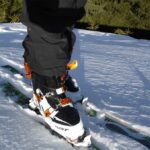There’s nothing more frustrating than being midway through a tough run on the slopes to have your vision impaired by your goggles fogging up causing you to have to stop and remove them or even wait for the fog to pass before continuing with the run.
Over the years, the technology and design of goggles have come on leaps and bounds, with many featuring fan-assisted ventilation systems to help keep the fogging away, however, we all know how nature works, and sometimes there is no way about preventing fog from building inside your goggles.

Whilst it’s not possible to prevent fogging 100%, we’ve learned from our years of snow sports what tips and tricks can help prevent fogging so you won’t have to stop and start to sort your goggles out on the slopes.
Keep on reading to find out the 13 best ways to prevent your skiing goggles from fogging.
Learn Why Fogging Occurs In Your Ski Goggles
The best tip we can offer to prevent your skiing goggles from fogging is learning what causes them to fog up so you can minimize doing that.
Make mental notes when you’re skiing to see when your ski goggles fog up the most and try out some of our tips below to see if this minimizes or prevents the fogging.
The fogging occurs because the warm air and moisture inside your goggles (created from your body heat because you’re moving) comes into contact with the cold air on the lens of the goggles (caused by the cold snowy weather outdoors).
The warm air will then cause condensation on your lens which is then turned into fog.
We’d recommend trying to minimize the amount of moisture inside your goggles and also keeping the temperature beneath your goggles the same as the outdoor temperature to minimize condensation occurring, but we’ll be touching on tips for this a bit further down.
You can apply an anti-fog solution onto your goggles before you hit the slopes but these will only be able to withstand a certain amount of moisture before it breaks down and your goggles begin fogging again.
Keep On Moving
Most newer models of skiing goggles should have built-in ventilation systems that keep fogging to a minimum by letting the cool air in and the warm air out to keep the temperature inside the goggles the same/or similar to the outdoor temperature.
Keeping your body moving will increase the airflow and therefore the ventilation in your goggles so instead of waiting for your goggles to defog as you get off the lift, slowly move down the run and wait to see if the airflow manages to decrease the fogging.
Obviously do not hit the slopes at full speed if you can’t see anything.
Lift Them Off Your Face
We totally understand if you don’t feel comfortable beginning your journey down the slopes with your goggles still fogging, so that’s why it might be best to just lift them off your face slightly for a few seconds to increase the airflow and therefore decrease the moisture and warm air beneath them.
The same goes if you’re on the ski lift, you can often end up being there for a while and the lack of motion can cause the goggles to fog up. Take this time to lift them off for a moment ready for when you get off.
Try to avoid touching your goggles if you have moisture as it’ll cause the vents to become dampened and decrease ventilation which will make fogging worse. If possible, ask a friend to do it for you or remove your ski gloves if you have enough time.
Find A Helmet That Has A Visor

Chances are there’ll be a time when the snow is falling whilst you’re making your way down the slopes and whilst the scenes can be stunning, this can be a recipe for disaster for your goggles’ vents.
Without a visor, moisture will top off your goggles and into the vents which will then make fogging a bigger problem than before. However, you don’t want to get a visor that completely cuts off ventilation to your goggles as this will also make fogging worse - confusing? We know!
We’d recommend buying your ski helmet and goggles at the same time so you can ensure there is enough ventilation when wearing a helmet but still preventing the moisture from the snow from getting into the goggles.
Check Padding And Vents For Moisture
Sometimes there’s nothing you can do about moisture getting into the vents on your goggles, heavy snowfall or even a few falls down the slopes can easily allow moisture to get on them.
Moisture will create all sorts of problems for your goggles and you’ll want to sort it out as soon as possible otherwise you may have to face a day on the slopes without them until they’re ready to use again.
Tap your goggles against a hard surface you can find, a tree or even your ski poles will do to get any excess snow off, and do not use your glove or other skiing clothing to wipe away the snow as this will press the snow and additional moisture into the vents.
Unfortunately, if your goggles have become totally smothered by the snow due to a fall or you’ve dropped them during a break, then it may be game over for them for the day and you’ll have to let them dry naturally and swap them out for another pair or your sunglasses.
Don’t Wear Too Many Layers
Many people who try skiing for the first time always comment upon how surprised they were about how warm it gets when you’re out on the slopes.
Not only are you constantly moving your body but the sun can often be shining throughout the entire day which means you may even build up a bit of a sweat.
Don’t wear too many layers and dry to dress for the temperature outside despite there being a ton of snow on the ground. If it does get too hot then take a layer off or open up some of the vents on your ski clothes to provide some ventilation for your body and to help cool you down.
The more layers you wear on a sunny day on the slopes, the more you will end up sweating and the heat and moisture from your body will rise to the top of your head and then go to your goggles which will increase fogging.
Don’t Keep Your Goggles Upon Your Head
As we mentioned above, when you’re hot and sweaty from racing down the slopes the heat and mixture your body produces will rise to your head so the last thing you’ll want to do is to rest your goggles there when you’re not skiing.
Not only this but due to the hard material of ski helmets your goggles will be prone to slipping off and possibly falling into the snow where the vents could become full of moisture.
You should try to avoid taking off your goggles unless you’re allowing extra ventilation when on the ski left or once after you’ve finished skiing.
Be Careful What You Wipe The Fog With
It’s best to never use any of your skiing clothing to wipe away the fog on your goggles, especially your gloves as these will have come in contact with the snow and you’ll push more moisture into the lens instead of wiping it dry.
You may even end up scratching the surfaces of the lens which could make your vision impaired or even damage the anti-fog coating that it has been treated with.
Try to keep microfiber clothing in a dry pocket on you at all times if your goggles do happen to get wet. Make sure it is microfiber as you don't want any of the material getting stuck to the wet lens and making it difficult for you to see out of.
Upgrade Your Old Pair Of Goggles
We hate to be the bearer of bad news but unfortunately, sometimes old goggles just need upgrading and replacing to make your skiing experience more comfortable and enjoyable.
Older goggles aren’t built with the technology required to prevent fogging such as anti-fog treatment, proper ventilation, and double-pane lenses which help to minimize moisture build-up underneath the goggles.
Don’t worry though as even some budget-friendly models are equipped with anti-fog features that’ll minimize fogging when you’re skiing.
As time goes on, we’re sure the ski equipment manufacturers will discover an innovation that will eradicate fogging in skiing goggles completely to make ski enthusiasts' lives a lot easier.
Don’t Tuck Face Coverings Under Your Goggles
Trust us, we know that feeling of when the ice-cool temperature first hits you when you leave your lodge to hit the slopes in the morning.
You end up wrapping up in lots of layers and also keeping your neck warmer firmly tucked under your goggles to keep your face covered, but this makes things worse.
The warm air from your breath and also the body heat that you produce whilst you’re skiing will get stuck in your neck warmer and your goggles creating moisture and thus fogging up.
Try to leave a gap between your goggles and your neck warmer, or at least make sure your mouth and nose aren’t covered with your goggles securing them on top.
Leave Your Goggles To Dry Properly At The End Of The Day
It can be tempting at the end of the day to leave all your skiing gear outside the lodge whilst you head inside to warm up. However, it’s very important to take your ski goggles inside with you to allow them to dry naturally overnight ready for the next day.
Replace Your Ski Mask With One With Better Ventilation
If you are skiing in freezing temperatures and you can’t be without a ski mask then make sure the one you have has good ventilation or invest in a new one that has.
It should have a mouth hole for you to breathe out of and it should be made of a mesh material to allow hot air to ventilate through so it doesn’t rise into your goggles.
Keep Another Pair Of Goggles To Hand
Even leaving your goggles to dry overnight is not enough for them to dry properly so the second-best option is to have another spare handy ready to wear if they’re not dry enough.
- How to Train in the Summer for Cross-Country Skiing: Off-Season Strategies for Peak Performance - April 19, 2024
- Ski Lift Ticket Prices in Colorado [For 2024 Season] - January 26, 2024
- How to Choose Classic Cross-Country Skis: A Guide for Beginners - November 10, 2023








